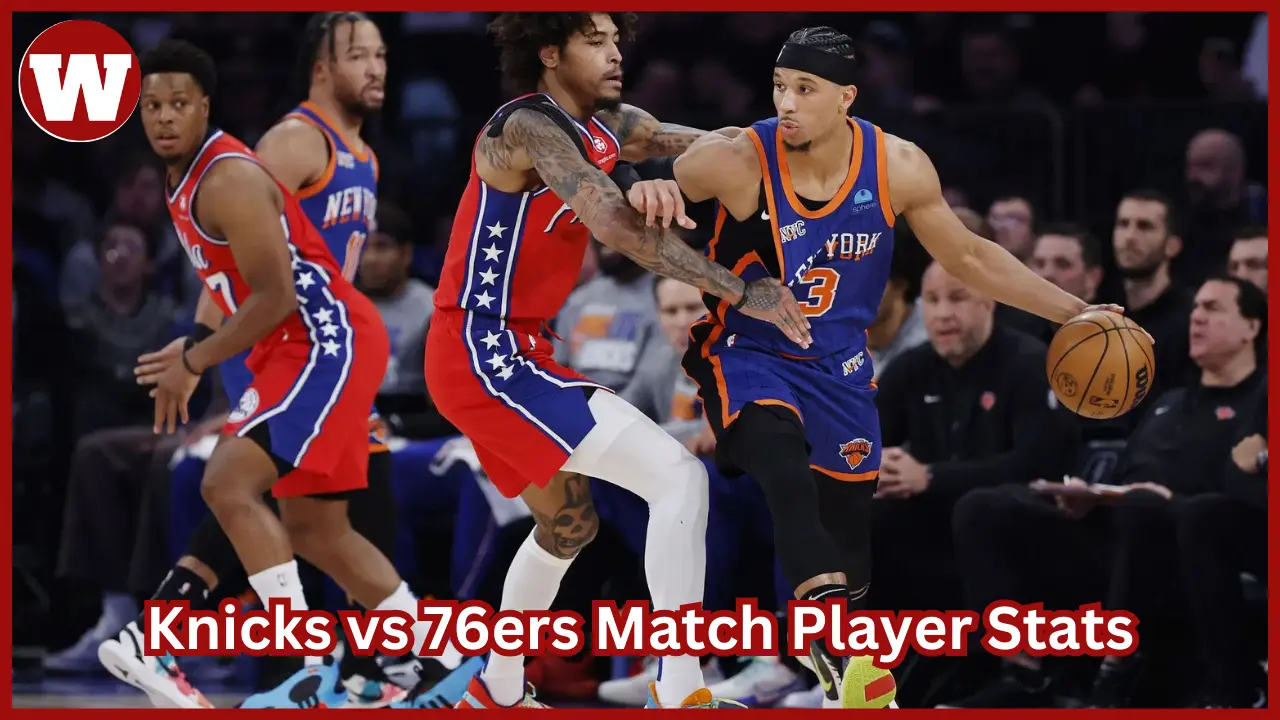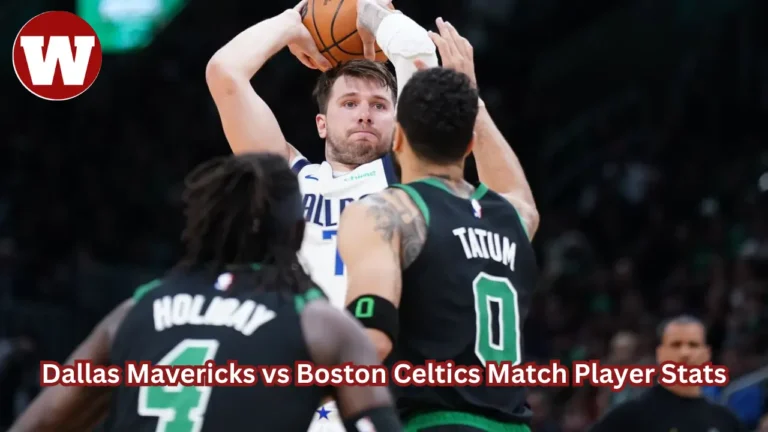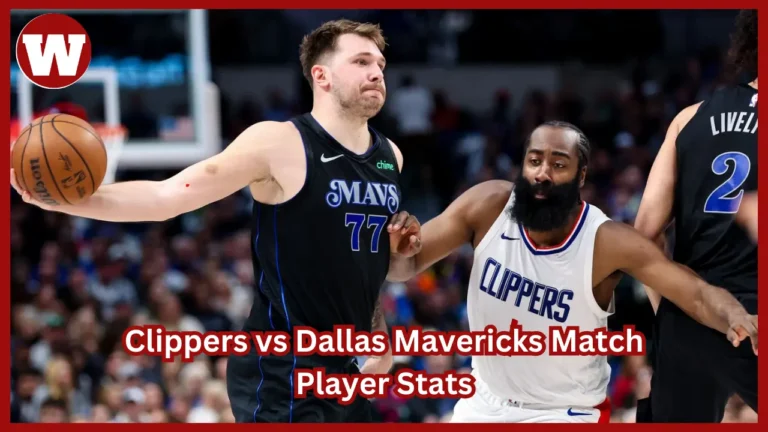It’s more than another game when the New York Knicks and Philadelphia 76ers clash on the basketball court. This matchup is where stats come alive, players push their limits, and strategies unfold in real time. Both teams boast star-studded rosters, making every face-off an intense battle, with every stat carrying weight for the final result.
Fans know that “Knicks vs 76ers match player stats” provide more than just numbers; they give insight into each team’s strengths, strategies, and key players. In these matchups, individual performances by stars like Julius Randle and Joel Embiid reveal tactical choices and highlight pivotal moments that could shape the entire NBA season.
Here, we delve into the most recent Knicks vs 76ers game, analyzing standout player stats, game tactics, and memorable plays that keep fans on the edge. This breakdown serves as your guide to understanding the dynamics, talent, and strategy that characterize this NBA rivalry.
Best Player Performances
Julius Randle’s Impact on Knicks’ Offense
Scoring Efficiency
Julius Randle remains one of the Knicks’ most consistent scorers, known for his high shooting accuracy and playmaking ability. In the latest game, Randle scored 27 points, showcasing his prowess in mid-range shooting and his ability to penetrate the defense, keeping the 76ers on high alert.
Rebounding Dominance
With 10 rebounds in the recent matchup, Randle’s presence in the paint was crucial. His offensive rebounding helped the Knicks secure second-chance points, a factor that narrowed the scoring gap at critical moments. Randle’s rebounding also disrupted the 76ers’ attempts at fast breaks, slowing down their pace.
Leadership on Court
Beyond his stats, Randle’s leadership was evident as he motivated teammates during tough defensive possessions. His energy and strategic direction gave the Knicks a boost, especially during high-pressure moments, making him a pillar of both morale and gameplay.
Joel Embiid’s Defensive and Offensive Impact
Defensive Skills
Embiid’s defensive strength shone as he recorded 3 blocks and 2 steals, using his size and quick reflexes to prevent key Knicks players from scoring in the paint. Embiid’s ability to alter shots forced the Knicks to rely on perimeter shooting, adjusting their game plan.
Scoring Presence
Leading the 76ers with 32 points, Embiid’s scoring ability was undeniable. His accurate free throws, coupled with his skill in drawing fouls, made him a persistent offensive threat. The Knicks struggled to contain his inside plays, which heavily contributed to the 76ers’ offensive dominance.
Commanding the Paint
Embiid’s control of the paint effectively limited the Knicks’ opportunities to score inside. His physical presence and positioning made him a barrier, with the Knicks finding it challenging to score from close range, forcing them to adapt with perimeter shots.
Jalen Brunson’s Role as a Playmaker
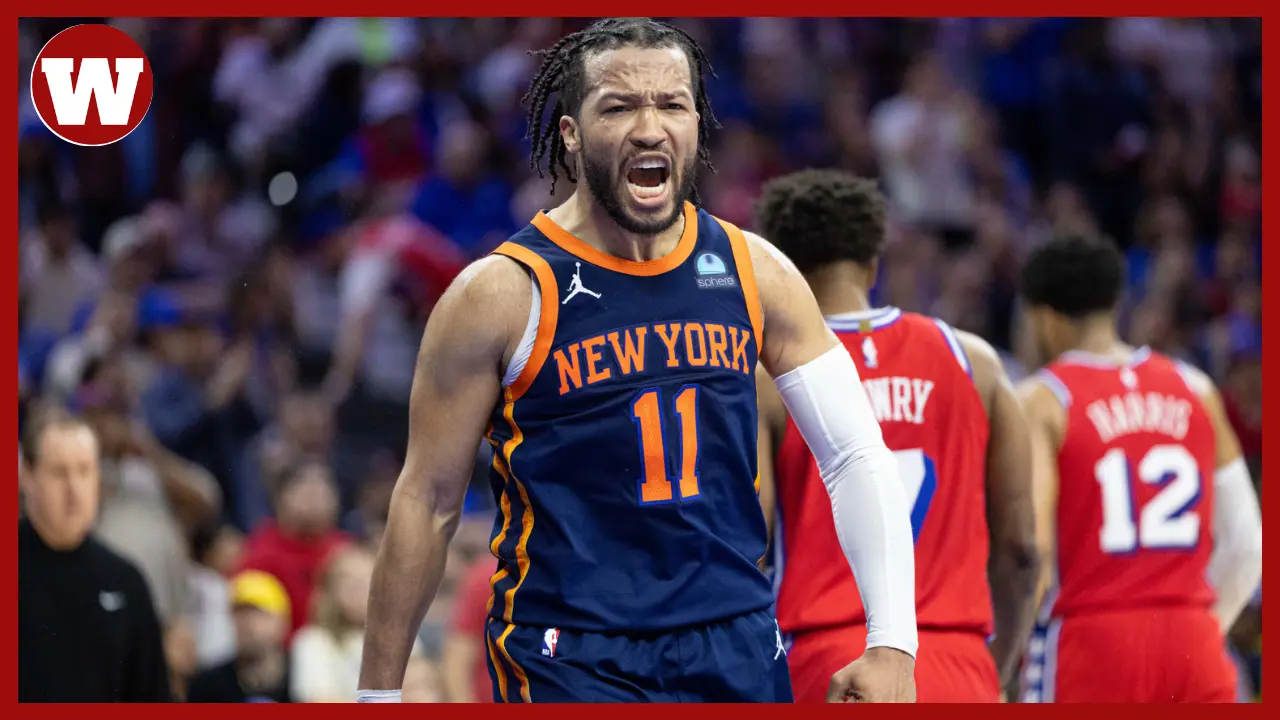
Assists and Playmaking
Jalen Brunson’s playmaking ability was instrumental in the Knicks’ offensive strategy. With 8 assists, he facilitated open shots for teammates like Randle and Barrett, helping the Knicks maintain scoring pressure despite the 76ers’ defense.
Defensive Effort
Brunson’s 2 steals reflect his defensive impact, putting pressure on the 76ers’ guards. His defensive effort often disrupted their rhythm, especially in the second and third quarters, where the Knicks aimed to catch up.
Clutch Performance
Brunson’s 4th-quarter scoring maintained the Knicks’ chances, making him essential in high-stakes moments. His knack for clutch shots and precise passing under pressure showed why he is a trusted playmaker for the Knicks.
Read Also: Dallas Mavericks vs Boston Celtics Match Player Stats
Team Strategies and Execution
Knicks’ Offensive Approach
Three-Point Shooting
The Knicks leveraged three-point shooting as a counter to Embiid’s defensive control inside. Players like Barrett and Quickley capitalized on open three-point shots, spreading the 76ers’ defense and allowing for more versatile scoring options.
Attacking the Paint
Despite Embiid’s dominance, the Knicks made several attempts to drive inside, seeking fouls or close-range opportunities. Randle and Robinson’s inside drives were calculated moves to challenge the 76ers’ paint defense.
Ball Movement
The Knicks focused on fast-paced ball movement, aiming to outmaneuver the 76ers’ defensive setups. This allowed them to find gaps and create scoring chances, which were essential for maintaining offensive momentum.
76ers’ Defensive Tactics
Zone Defense
Philadelphia’s reliance on zone defense in this game disrupted the Knicks’ flow. The 76ers used this strategy to limit Randle and Brunson’s ability to drive, effectively containing scoring attempts within the mid-range area.
Rebounding Strength
With Embiid leading, the 76ers dominated the boards, winning critical rebounds on both ends. Their defensive rebounding minimized the Knicks’ second-chance points, while offensive rebounds extended their scoring opportunities.
Forced Turnovers
The 76ers’ aggressive pressure on the Knicks’ guards led to forced turnovers, translating into fast-break points. These turnovers shifted momentum and provided the 76ers with crucial points, especially during the Knicks’ attempted comebacks.
Knicks’ Defensive Adjustments
Double-Teaming Embiid
To mitigate Embiid’s impact, the Knicks frequently double-teamed him, attempting to force passes out of the post. This strategy, though not entirely successful, managed to momentarily slow down the 76ers’ scoring from the inside.
Perimeter Defense
With players like Harden in the 76ers’ lineup, the Knicks tightened their perimeter defense to prevent long-range shots. This focus on closing out shooters helped keep Philadelphia’s three-point attempts in check.
Transition Defense
The Knicks made strong transition efforts to slow down the 76ers’ fast breaks. Quick defensive setups were key in minimizing points off turnovers, helping the Knicks keep the game competitive.
Analysis of Key Matchup Elements
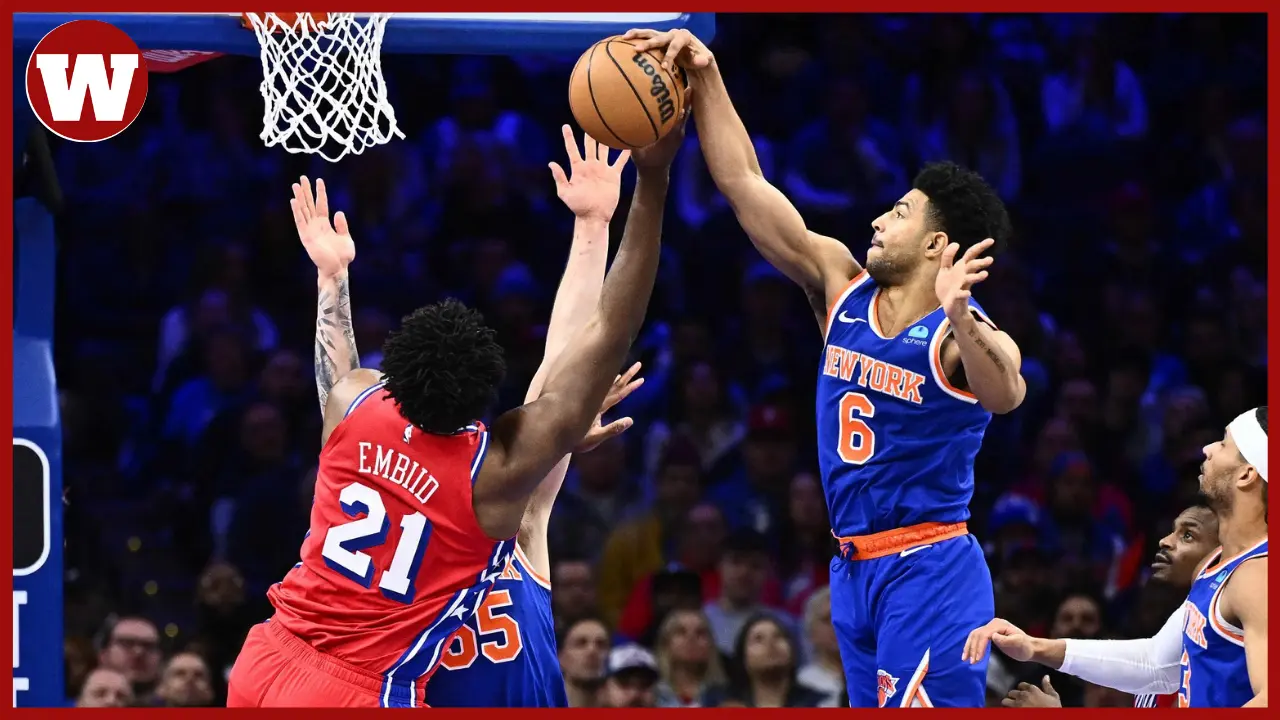
Shooting Efficiency Comparison
Knicks’ Perimeter Shooting
The Knicks leaned heavily on their three-point shooting in this matchup. Players like RJ Barrett and Quentin Grimes contributed significantly from beyond the arc, with Barrett hitting crucial shots to stretch the 76ers’ defense. This perimeter approach was crucial to compensating for Embiid’s defensive presence inside.
76ers’ Inside Scoring
The 76ers showcased their dominance in the paint, with Embiid and Tobias Harris consistently scoring close to the basket. This inside scoring allowed Philadelphia to control the tempo, as they faced fewer contested shots within the paint.
Free-Throw Accuracy
Both teams relied on drawing fouls, leading to multiple trips to the free-throw line. Embiid’s proficiency at free throws gave the 76ers an edge, allowing them to maintain a scoring buffer. Meanwhile, Randle’s free-throw performance kept the Knicks within reach during critical moments.
Defensive Matchups and Adjustments
Knicks’ Defense on Harden
The Knicks employed aggressive defense against James Harden, aiming to limit his playmaking abilities. By assigning Grimes and sometimes Barrett to Harden, the Knicks managed to curtail his scoring and assist contributions.
76ers’ Defense on Randle
The 76ers’ defensive approach on Julius Randle involved frequent double-teaming, forcing him to pass out of difficult situations. This tactic limited Randle’s scoring in some instances, though it opened opportunities for other Knicks players.
Team Rebounding Strategy
Rebounding was a focal point for both teams. The 76ers, with Embiid and Harris, leveraged their height and physicality, winning critical rebounds. The Knicks, however, relied on positioning and quick reactions from players like Mitchell Robinson to contest the 76ers’ rebounding dominance.
Bench Contributions
Knicks’ Bench Performance
The Knicks’ bench, led by Immanuel Quickley and Obi Toppin, contributed vital points and energy. Quickley’s defensive hustle and shooting added momentum during the second quarter, while Toppin’s presence in the paint provided offensive rebounds and second-chance opportunities.
76ers’ Bench Depth
The 76ers’ bench also played a crucial role, with players like Georges Niang and Matisse Thybulle bringing defensive energy and scoring support. Niang’s three-point shooting helped maintain the 76ers’ lead, while Thybulle’s defensive plays created turnovers that fueled Philadelphia’s transition offense.
Read Also: Clippers vs Dallas Mavericks Match Player Stats
Impact of Coaching Strategies
Knicks’ Game Plan
Rotational Adjustments
Coach Tom Thibodeau strategically adjusted player rotations to match the 76ers’ lineup, particularly during the third quarter. By rotating Randle and Robinson in different intervals, he aimed to counter Embiid’s impact, allowing the Knicks to stay competitive.
Focus on Transition Offense
Thibodeau emphasized transition play to exploit the 76ers’ slower defensive setup after missed shots. This approach allowed the Knicks to create quick scoring opportunities before the 76ers could establish their defensive structure, keeping the pace of the game dynamic.
Defensive Switches on Key Players
Switching defenders on Embiid and Harden was another strategic move. Thibodeau’s use of double teams forced the 76ers’ stars to pass, disrupting their usual scoring patterns and creating scoring opportunities from turnovers.
76ers’ Coaching Decisions
Defensive Prioritization on Randle and Brunson
Coach Doc Rivers prioritized defense on the Knicks’ primary scorers, applying pressure to limit their scoring options. The team’s commitment to closing out on Randle and Brunson kept the Knicks’ offensive output lower, contributing to the 76ers’ lead.
Optimizing embiid’s Usage
Rivers used Embiid effectively, focusing his energy on defensive rebounds and paint protection. By optimizing Embiid’s time on the court, the 76ers maximized his influence on the game, allowing him to play efficiently without risking foul trouble.
Utilizing Zone Defense
Philadelphia’s use of zone defense disrupted the Knicks’ offensive structure, particularly during the second half. This strategy helped contain Randle and the Knicks’ inside scorers, forcing New York to rely more on three-pointers, which was inconsistent throughout the game.
Key Takeaways from the Knicks vs. 76ers Game
Momentum Shifts and Turning Points
Critical 3-Point Shots
The game’s momentum frequently shifted due to critical three-pointers. Barrett’s clutch shots kept the Knicks in the game, while timely shots from Niang gave the 76ers an edge, proving that three-point accuracy was pivotal in this contest.
Fouls and Free Throws
Both teams focused on drawing fouls, especially in the final quarter. Embiid’s ability to draw fouls and convert free throws consistently kept the 76ers ahead, while the Knicks’ missed free throws at key moments impacted their ability to close the gap.
Defense Leading to Offense
The 76ers’ defense created fast-break opportunities, especially through forced turnovers. These transitions led to easy points, making it difficult for the Knicks to recover. Philadelphia’s ability to turn defense into offense was a decisive factor in securing their lead.
Conclusion
The Knicks vs. 76ers match showcased a high-stakes battle of skill, strategy, and player stats that captivated NBA fans. From Randle’s offensive resilience to Embiid’s defensive dominance, each player’s performance influenced the outcome, providing insights into the tactical depth of this NBA rivalry.
Ultimately, the 76ers’ defensive tactics and offensive consistency allowed them to maintain control in the final moments, while the Knicks displayed tenacity and adaptability. This game serves as a snapshot of the talent and strategies that make Knicks vs. 76ers matchups so compelling, leaving fans eagerly awaiting their next clash.

